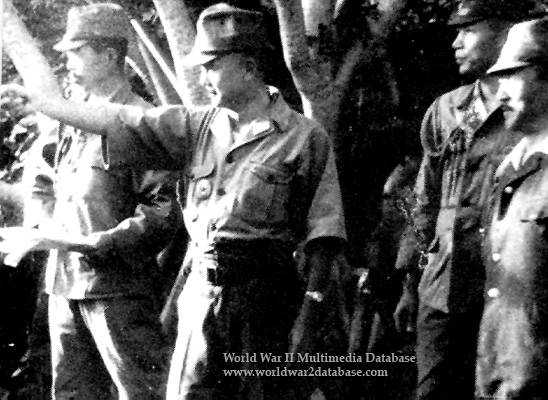| Imperial Japanese Army General Tadamichi Kuribayashi consults with his staff about defenses. Japan began fortifying the Bonins (Ogasawaras) in 1914. By 1943 an airfield was constructed on Iwo Jima. After the fall of Saipan in June 1944 the Japanese began building its defenses in earnest. Kuribayashi assumed command of the Imperial Japanese Army‘s 109th Division and was personally charged by Emperor Hirohito with defending Iwo Jima. The major units of Kuribayashi‘s command on Iwo were the Second Mixed Brigade commanded by Major General Sadasue Senda; Colonel Masuo Ikeda‘s 145th Infantry Regiment; and theThird Battalion, 17th Mixed Infantry Regiment under Major Tamachi Fujiwara. All the artillery on the island was organized into a Brigade Artillery Group under Colonel Kaido. Command of the naval forces fell to Imperial Japanese Navy Rear Admiral Toshinosuke Ichimaru. He was commanding officer of the 27th Air Flotilla, under the 3d Air Fleet. Nominally, all army forces were under General Kuribayashi and all naval forces under Admiral Ichimaru, but actually there were three major headquarters operating autonomously. These were the 109th Division, the Second Mixed Brigade, and the Naval Land Force. Naval tacticians felt that the beach must be heavily defended and decisive combat be joined with the enemy at the water‘s edge.Third Fleet Headquarters urged that the navy be permitted to construct pillboxes on the east and west beaches and in the vicinity of Airfield Number 1. Not enthusiastic, in August 1944 Kuribayashi authorized construction. His own plan was simple and well adapted to the terrain and size of the island. He abandoned the idea of all-out counterattacks against the beachhead and costly banzai charges. Instead, strong, mutually supporting positions were to be occupied prior to D-Day and defended to the death. An elaborate system of caves, concrete blockhouses, and pillboxes was commenced soon after the fall of Saipan, and continued until D-Day. Positions were sited to deliver flanking fire and constructed of reinforced concrete with walls as much as four feet thick, and with sand piled as high as 50 feet in front. Natural caves were improved, their entrances camouflaged, provided with multiple entrances and designed so that shelling could not hit them directly. They sheltered as many as 400 men. The man-made caves were 30 to 40 feet deep and complete with stairways, interlacing corridors, and passageways. The brigade headquarters, located about 800 yards east of Airfield Number 2, consisted of circular tunnels capable of sheltering 2,000 troops. Miles of tunnels connected many of the defenses. | |
| Image Filename | wwii1174.jpg |
| Image Size | 150.98 KB |
| Image Dimensions | 548 x 400 |
| Photographer | Unknown |
| Photographer Title | |
| Caption Author | Jason McDonald |
| Date Photographed | January 01, 1945 |
| Location | |
| City | Iwo Jima |
| State or Province | Bonins |
| Country | Japan |
| Archive | |
| Record Number | |
| Status | Caption ©2007, ©2024 MFA Productions LLC Please Do Not Duplicate or Distribute Without Permission |

Author of the World War II Multimedia Database

